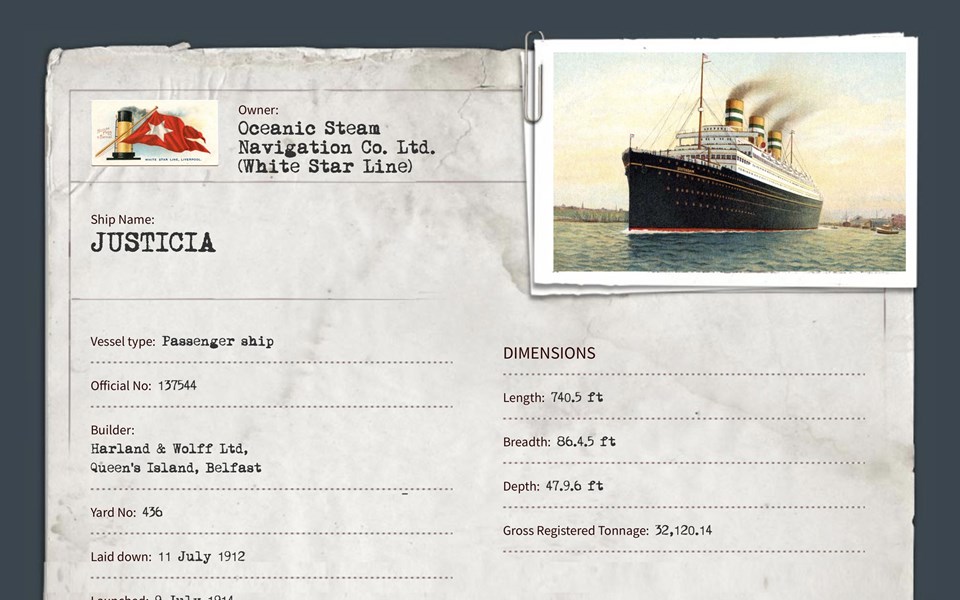Justicia Fact File
Owner: Oceanic Steam Navigation Co. Ltd. (White Star Line)
Ship Details
Details
Vessel Type: Passenger ship
Official No: 137544
Builder: Harland & Wolff Ltd, Queen's Island, Belfast
Yard No: 436
Laid down: 11 July 1912
Launched: 9 July 1914
Handed over: 7 April 1917 (as Justicia)
Port & Date of Registry: Liverpool, 27 March 1917
Managing Owner & Address: Colonel Henry Concanon, 30 James Street, Liverpool
Description
Number of Decks: 2 (Lloyd's Register list 4/5 decks)
Number of Masts: 2
Rigged: Schooner
Stern: Elliptical
Build: Clencher
Framework & Description of Vessel: Steel
Number of Bulkheads: 11
Number of water ballast tanks: 18
Dimensions
Length: 740.5 ft
Breadth: 86.4.5 ft
Depth: 47.9.6 ft
Gross Registered Tonnage: 32,120.14
Machinery
Engine Builder: Harland & Wolff Ltd, Belfast
Engine Type: 2 X inverted direct acting triple expansion surface condensing, 1 X low pressure turbine
Cylinders: 2 X 35½; 2 X 56; 4 X 64 inches
Stroke: 60 inches
Nominal Horse Power: 2,903
Boilers
Description: Double and horizontal cylindrical return tube
Number: 12
Iron or Steel: Steel
Pressure when loaded: 215 lbs
Screw: Triple
Speed: 17 knots
Signal Letters: J. P. F. L.
NOTES
The third largest merchant vessel lost through enemy action during the First World War belonged to the White Star Line. The largest lost was Britannic (Yard No. 433), next, the Cunarder Lusitania and then Justicia. Originally laid down and launched as Statendam for the Holland-America Line the liner was similar in many respects to the 'Olympic' class, only smaller and together with the Red Star liner Belgenland (Yard No. 391) the five giants were planned by the International Mercantile Marine Company to dominate the transatlantic passenger trade. This was never to come to pass. The uncompleted liner was requisitioned by the British Government. Intended to serve with Cunard, with the name Ruritania, a replacement for Lusitania, the Company were unable to muster a crew so the vessel was handed over to White Star and renamed Justicia (Latin for Justice). Completed as a troop transport, she entered service in April 1917.
In what was described at the time as 'the most extraordinary sea fight of the war' Justicia was attacked off the north coast of Ireland by two German U-Boats that fired seven torpedoes at their target. Two were exploded by Justicia's own gun crews and two missed their mark, but three found their target during a battle lasting twenty-four hours. Despite the efforts of a protective screen of twelve Royal Naval destroyers, two sloops, two armed yachts and eight trawlers the U-boats pressed home their attacks and eventually succeeded in sinking the transport on 20 July 1918 near Rathlin Island.

